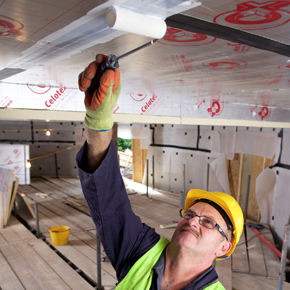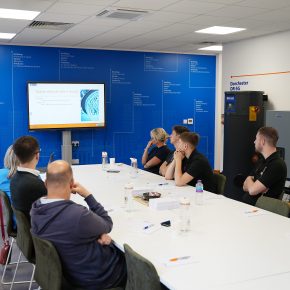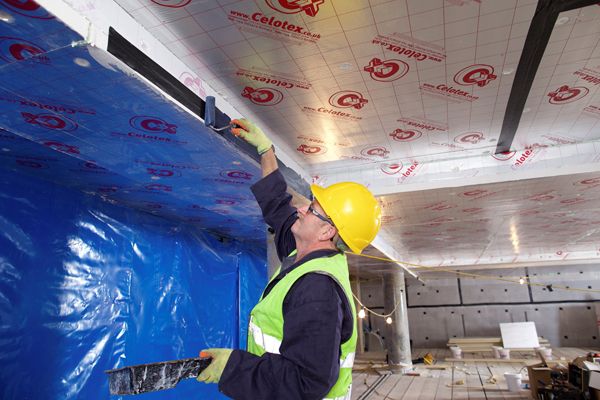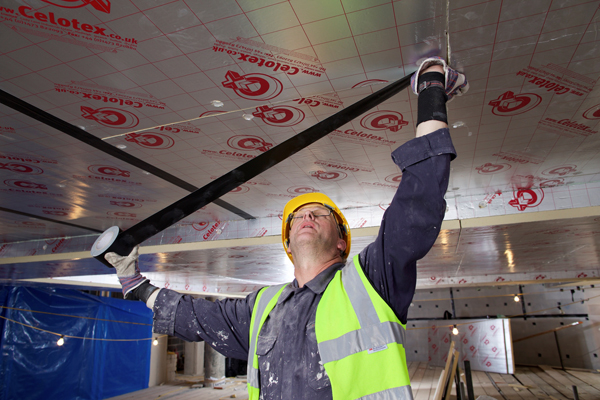
Drybase liquid applied vapour barrier specified for underground swimming pool
Drybase Liquid Applied DPM from Safeguard Europe has been specified as part of the construction of a partly underground private swimming pool, at an architect-designed home in Bardsey, north of Leeds.
The owner of the property wanted to install a swimming pool in the lower ground floor. This cut into the side of a hill so that two walls were effectively underground, with the ceiling providing a terrace at the upper ground floor level.
The construction required the installation of air vapour control layers, as recommended in BS5250: 2011 ‘code of practice for control of condensation in buildings’ that points out that applying thermal insulation internally separates the warm interior from the cold masonry, creating a risk of interstitial condensation behind the thermal insulation. This can be avoided by applying an AVCL on the warm side of the thermal insulation.
The Drybase vapour control layer was recommended by Yorkshire Dampcourse for its excellent adhesion properties and its practicality as a easy-to-apply seamless system.
Vapour control barrier
Vandex Uniflex, a high strength adhesive, was used in addition to mechanical insulation fixings to fit the insulation boards into position. The butt joints were then filled with expanding foam to reduce the risk of cold spots. Once dry, this was then trimmed flush with the insulation before a moisture and chemical resistant fibre tape was applied.
Matt Tuncy, director of Yorkshire Dampcourse, explained: “If we had used a sheeting system as a vapour barrier it would have been difficult to avoid any sagging. The ceiling slab is not flat as there are reinforcement beams below it so if we had applied a sheet material there would have been a lot of cutting, folding and taping around these.
If any of the following trades had damaged it, then we would have had to patch the sheeting creating more taped joints. I felt that the more joints there were, the more risk there was of a failure.”
Flexible and elastic membrane
Supplied ready-to-use from the tub, Drybase can be applied to damp substrates by brush, roller or spray. The vapour control layer is typically touch-dry within an hour of application, and will cover up to 4.5m2 depending on the substrate surface texture.
Once the two-coat product is applied, it cures to form a membrane that is flexible, elastic and provides a barrier to damp and ground gases including radon, carbon dioxide and methane.
Further products from the Safeguard Europe range were used to tackle the failed waterproofing in the original building structure. Yorkshire Dampcourse installed Oldroyd XV, an internally-applied cavity drain system, in addition to Vandex BB75E, an elasticised waterproofing slurry that is applied directly onto the basement wall by trowel or spray, and Aquadrain drainage channels.
Contact:
Safeguard Europe,
Redkiln Close,
Horsham,
West Sussex,
United Kingdom,
RH13 5QL
Phone: 01403 210204
Fax: 01403 217529
Visit Safeguard Europe's website
Visit Supplier's page
Latest news

24th April 2024
The lowdown on Origin’s New Soho Offering
Origin’s Soho External Door is the first launch in its new generation of products, setting a higher standard for the fenestration industry.
Posted in Access Control & Door Entry Systems, Aluminium Products, Architectural Ironmongery, Articles, Building Industry News, Building Products & Structures, Building Systems, Doors, Innovations & New Products, Posts, Restoration & Refurbishment, Retrofit & Renovation, Security and Fire Protection
24th April 2024
Mitsubishi Electric welcomes new code of conduct for smart appliances
Mitsubishi Electric welcomes a new code of conduct on energy smart appliances which the European Union (EU) announced yesterday at the Hannover Fair in Germany.
Posted in Air Conditioning, Articles, Building Industry Events, Building Industry News, Building Products & Structures, Building Regulations & Accreditations, Building Services, Exhibitions and Conferences, Facility Management & Building Services, Heating Systems, Controls and Management, Heating, Ventilation and Air Conditioning - HVAC, Plumbing, Retrofit & Renovation, Seminars, Sustainability & Energy Efficiency
24th April 2024
Hamworthy Heating expands CIBSE approved CPD modules with new hot water series
Hamworthy Heating, technical experts in commercial heating and hot water products, announce the expansion of its market leading CIBSE approved Continuing Professional Development (CPD) portfolio with the launch of three new learning modules.
Posted in Articles, Building Industry Events, Building Industry News, Building Products & Structures, Building Services, Continuing Professional Development (CPD's), Facility Management & Building Services, Heating Systems, Controls and Management, Heating, Ventilation and Air Conditioning - HVAC, Plumbing, Retrofit & Renovation, Seminars, Training
24th April 2024
New technology partnership brings Passivent ventilation products to IESVE
Passivent has partnered with Integrated Environmental Solutions (IES) to make a number of its products available to model within the Virtual Environment (VE) platform IESVE.
Posted in Air Conditioning, Articles, Building Industry News, Building Products & Structures, Building Services, Facility Management & Building Services, Heating, Ventilation and Air Conditioning - HVAC, Information Technology, Innovations & New Products, Posts, Retrofit & Renovation, Roofs, Ventilation
 Sign up:
Sign up: 
